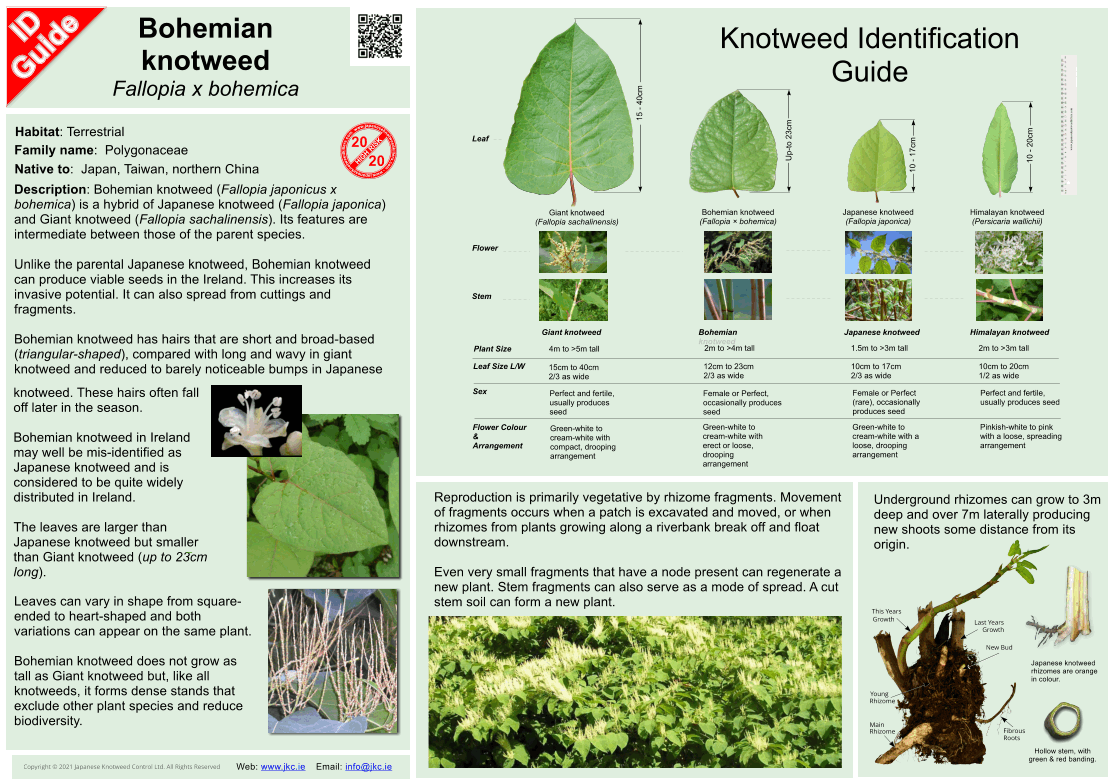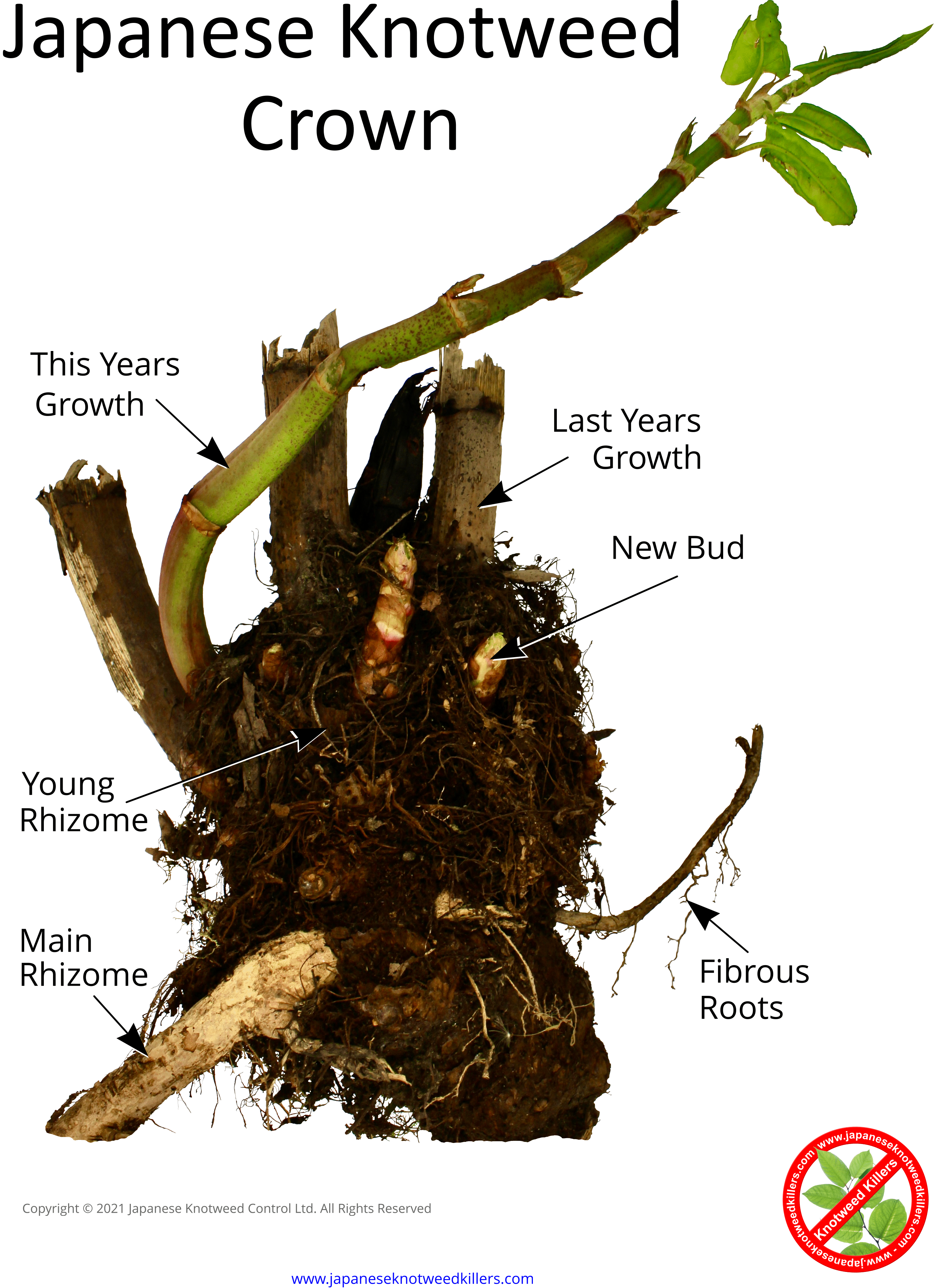

Ireland: Kerry - Dublin - Cork - Waterford - Roscommon - Galway - Belfast
UK: London - Manchester - Newcastle - Cardiff - Liverpool


Bohemian knotweed
Invasive Species Information

What Is Bohemian knotweed - (Fallopia x bohemica)?
Habitat: Terrestrial
Distribution in Ireland: Extensive
Status: Established
Family name: Polygonaceae
Bohemian knotweed Leaf
Reproduction: This species mostly spreads by vegetive means through stem and root fragments and is usually found in disturbed areas such as flood zones railway sidings and roadsides.
Most Bohemian knotweed plants are males and lack seeds.

However, more recently, seed-bearing hybrids have appeared, indicating a back-cross with Giant knotweed or Japanese knotweed. The existence of seeding hybrids may mean that this plant will begin to spread even more rapidly in the future.

Bohemian knotweed Flowers
Bohemian knotweed is a hybrid between Giant knotweed and Japanese Knotweed, sharing characteristics of both parent species. It was introduced to Ireland as an ornamental plant but has become widespread as a pest plant, especially along rivers and roadways.
Leaves can be either spade or heart-shaped, usually more heart-shaped lower down on the stems and more spade-shaped near the branch ends.
This variability in leaf shape is one identifying character since the parent species generally have either heart-shaped or spade-shaped leaves.
The leaves are also intermediate in texture between the parent species - thicker and rougher than Giant knotweed but less so than Japanese knotweed. On flowering stems, leaf tips are characteristically long and gradually tapered.
How To Identify Bohemian knotweed?

Leaf: Leaves can be either spade or heart-shaped, hairs on the leaf undersides especially along the mid-vein
Flower: creamy white to greenish white
Stem: reddish-brown and usually branched. stem nodes are swollen and surrounded by thin papery sheaths
Seed: The fruit is 3-sided, black and shiny
Bohemian knotweed - Fallopia x bohemica ID Guide
A key identifying feature is the hairs on the leaf undersides especially along the mid-vein. Bohemian knotweed has hairs that are short and broad-based (triangular-shaped), compared with long and wavy in Giant knotweed and reduced to barely noticeable bumps in Japanese knotweed. These hairs are easiest to see with a hand lens during the spring and summer, often falling off later in the season.

Knotweed Leaves & Flowers
The flowers are small, creamy white to greenish white, and grow in showy plume-like, branched clusters from leaf axils near the ends of the stems. Flower clusters are generally about the same length as the subtending leaf, unlike the shorter flower clusters found on giant knotweed and the longer clusters found on Japanese knotweed. Leaf and flower characters are most reliable when looking near the middle of a branch. The fruit is 3-sided, black and shiny.
Plants are usually 2m to 3m tall, shorter in dry areas.
Stems are stout, cane-like, hollow between the nodes, reddish-brown and usually branched. The plants die back above ground at the end of the growing season. However, the dead reddish-brown canes often persist throughout the winter. The stem nodes are swollen and surrounded by thin papery sheaths.
Why Is Bohemian knotweed A Problem?
Bohemian knotweed is an alien (non-native) invasive plant, meaning it out-competes crowds-out and displaces beneficial native plants that have been naturally growing in Ireland for centuries.
Due to their lack of natural predators, and their ability to spread by root and stem fragments, invasive knotweed species have spread and become widely established throughout Ireland.

Bohemian knotweed clones can completely clog small waterways and displace streamside vegetation, increasing bank erosion and lowering the quality of riparian habitat for fish and wildlife.
Rapid spring growth and deep, extensive roots enable knotweed to outcompete most other plants, even small trees and shrubs.
Bohemian knotweed can tolerate partial shade and are most competitive in moist, rich soil. Invasive knotweed species are commonly found along roadsides and on stream banks but also may be present in gardens, waste land, fields, parks. In fact it can appear just about anywhere!
Knotweed can cause extensive damage to building structures, road and driveway surfaces.
European Communities (Birds and Natural Habitats) Regulations 2011 non-native invasive plant species A-Z (Updated 2017)
There are currently 35 invasive plant species listed in the European Communities (Birds and Natural Habitats) Regulations (annex 2, Part 1)...
Click on a species from the following list to find out more regarding non-native species subject to restrictions under Regulations 49 and 50.
-
American Skunk-Cabbage - Lysichiton americanus
-
Red Alga - Grateloupia doryphora
-
Wakame - Undaria pinnatifida
-
Waterweeds - Elodea (all species)
Non-Native Plant Species identified as High Risk on Ireland's Biodiversity List...
Common name
Species name
Environment
Terrestrial
Freshwater
Terrestrial
Terrestrial
Marine
Freshwater
Freshwater
Freshwater
Terrestrial
Terrestrial
Terrestrial
Terrestrial
Marine
Terrestrial
Freshwater
Freshwater
Freshwater
Terrestrial
Freshwater
Marine
Risk score
20
19
18
19
18
19
21
20
19
18
18
19
19
20
20
19
20
20
20
18
